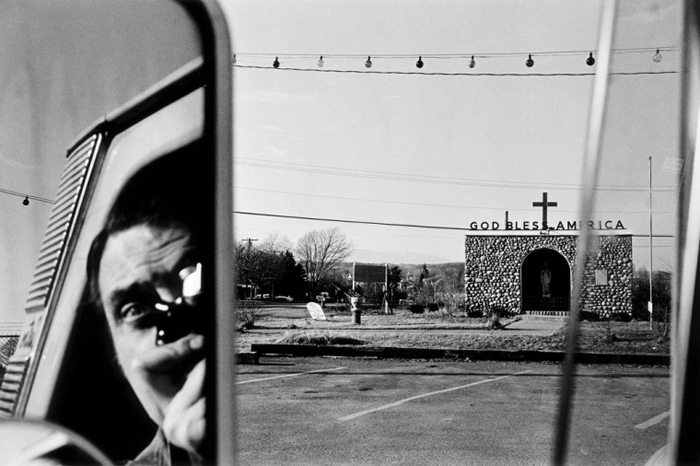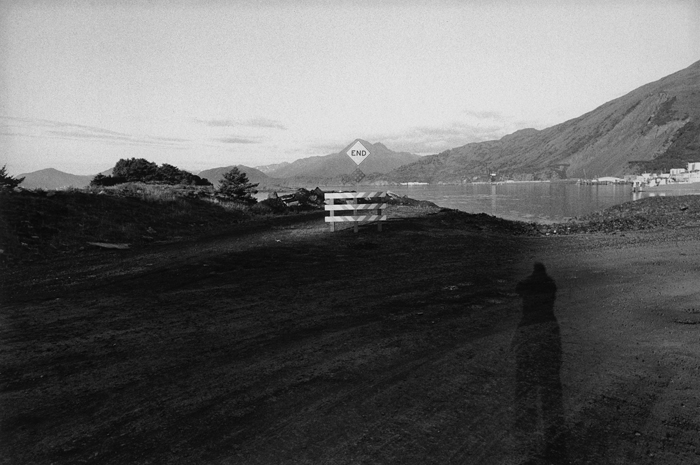
Lee Friedlander, Route 9W, New York State, 1969, from the book under discussion
Near the end of his book In the Picture: Self-Portraits 1958-2011, Lee Friedlander inserts an epigraph he attributes to César Vichard de Saint Réal (1639-1692): “A novel is a mirror passing down a road.” The source of this quote is another epigraph — the one with which Stendhal begins chapter 13 of The Red and the Black. It seems the quintessential expression of naïve realism, defining art as a mirror that merely reflects the world. What is it doing in a book by Lee Friedlander?
Friedlander loves mirrors, and his self-portraits often depend on reflections. At the same time, mirrors in Friedlander’s pictures aren’t the straightforward reflection of reality that the Saint Réal epigraph seems to celebrate. In his now classic 1970 book Self Portrait, Friedlander wrote that “the camera is not merely a reflecting pool and the photographs are not exactly the mirror, mirror on the wall that speaks with a twisted tongue.” Friedlander knows his mirrors obscure as much as they reveal, often comically so.
Friedlander also loves the road, and while many of his self-portraits (and mirrors) are in domestic and other interiors, he’s most characteristically a road-trip photographer, framing views through the car window or on small-town sidewalks. But Friedlander’s road isn’t just a symbol of American mobility or a stage for life’s parade. The photograph he has placed opposite the Saint-Réal epigraph (Kodiak, Alaska, 1988) was made at a road’s dead end. The “End” sign and barricade seem to announce the end of the book, but that too is a bit of a joke, because there are two brief sequences to go: a series of self-portraits of Friedlander almost meeting his end as a quadruple bypass patient (then recovering), and another series of self-portraits with photographer friends made during six road trips.

Lee Friedlander, Kodiak, Alaska, 1988, from the book under discussion
In his epigraph’s definition of the novel, is Stendhal endorsing the view that art only mirrors the world? Morris Dickstein, in his book A Mirror in the Roadway: Literature and the Real World, argues that “Stendhal’s mirror image is anything by mechanical: it points not to simple seeing but to the tricky ways of seeing through art”:
This is not a stationary mirror fixed upon the passing show, observing the parade as from the viewing stand, but a dynamic reflector shifting position as it moves down the road. It must be held or carried by someone, and the images it provides will be framed, constantly changing, a series of partial views contributing to a larger picture.He notes that elsewhere in the novel Stendhal again uses the image of the mirror carried in the road, reflecting stagnant puddles as readily as the azure sky. Dickstein, a canny cultural critic, then offers a line of thinking that brings us back to Friedlander:
To the modern eye this mirror eerily resembles a movie camera doing a sophisticated tracking shot — some sixty years before movies were invented, and several years before the beginnings of still photography. Or better still, these images of the sky above, the mud below, suggest a hand-held camera, which even today produces an appearance of artlessness . . . .Stendhal believed no more in the artlessness of mimesis than Friedlander does. But can the same be said for César Vichard de Saint-Réal? Here it turns out that Stendhal was putting one over on his readers. Saint-Réal was real enough, but as Dickstein explains, the saying is “undoubtedly by Stendhal himself,” who “often amused himself with bits of pseudoscholarship.” Dickstein argues that Saint-Réal served Stendhal in this bogus epigraph as a kind of “saint of the real,” a vehicle through which to make a subversive point about realism itself.
In the Picture is the most recent and exhaustive of Friedlander’s five books of self-portraits. It goes beyond the 1970 Self Portrait to include many later hand-held photographs of Friedlander with family and friends (selfies avant la lettre) and others made in medium-format, often with a cable release. When I added In the Picture to my shelf of Friedlander books, I spotted a slender, bright blue book I bought at the Fraenkel Gallery several years ago. It is titled simply Lee Friedlander and reproduces a selection of work from Friedlander’s concentrated return to self-portraiture in the 1990s. I opened it and found that it, too, prints an epigraph about mirrors:
To know one’s own state is not a simple matter. One cannot look directly at one’s own face with one’s own eyes, for example. One has no choice but to look at one’s reflection in the mirror. Through experience, we come to believe that the image is correct, but that is all. —The Wind-Up Bird Chronicle, Haruki MurakamiTwo books of self-portraits, two epigraphs about mirrors. The attribution to Murakami is correct. The attribution to Saint Réal is Stendhalian mischief. I’d wager that Friedlander is in on the joke.
